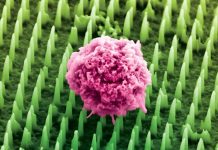
Think you don’t need to worry about COVID-19 while using a public restroom?
In a new study, researchers found that flushing public restroom toilets can release clouds of virus-laden aerosols for people to potentially inhale.
If that’s not cringe-worthy enough, after running additional computer simulations, they’ve concluded that flushing urinals do likewise.
The research was conducted by a team from Yangzhou University in China.
The researchers’ work clearly shows public restrooms can be dangerous places for potentially becoming infected from a virus, especially during the COVID-19 pandemic.
Other work has shown that both feces- and urine-based virus transmission is possible.
In the study, the team used a method of computational fluid dynamics to model the particle movement that occurs with the act of flushing.
The specific models are the volume of the fluids model and the discrete phase model.
Flushing a urinal, much like flushing a toilet, involves an interaction between gas and liquid interfaces.
The result of the flushing causes a large spread of aerosol particles to be released from the urinal, which the researchers simulated and tracked.
What the simulations revealed is disturbing. The trajectory of the tiny particles ejected by flushing a urinal manifests an external spread type, with more than 57% of the particles traveling away from the urinal.
But that’s not all. When men use urinals within a public restroom, these tiny particles can reach their thigh within 5.5 seconds when compared to the toilet flush, which takes 35 seconds to reach slightly higher.
Particles from urinals, however, show a more violent climbing tendency. The climbing speed is much faster than toilet flushing.
Urinals are used more frequently within densely populated areas, and the researchers point out that particles will travel faster and farther, which poses a serious public health challenge.
This work underscores how important it is to wear a mask within public places but especially restrooms.
The study is published in Physics of Fluids.
Copyright © 2020 Knowridge Science Report. All rights reserved.



